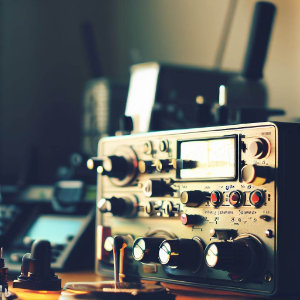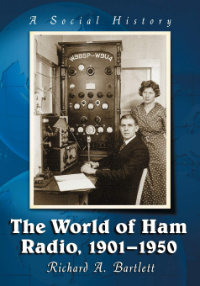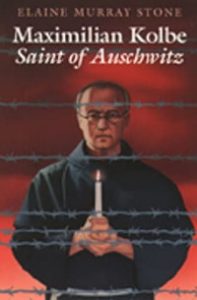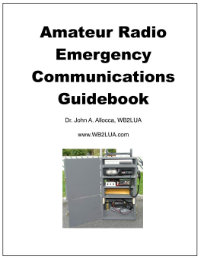Amateur radio, also known as ham radio, is a wireless communication service used by enthusiasts around the world to talk to each other and to send and receive messages. It has been around for over a century and has a long and interesting history.
Today, ham radio is a flexible activity; it is possible to follow in the footsteps of hams from years past or explore the cutting edge of technology. How has ham radio evolved over time to reach its current state?
Guglielmo Marconi was one of the initial people to experiment with radio technology as a hobby.
Guglielmo Marconi is often noted as the first “amateur” to transmit radio signals across the Atlantic Ocean in 1901, after building on the theory of Heinrich Rudolf Hertz that radio waves existed. Soon after, in the early 1900s, other amateurs began using the airwaves, and the first “wireless” club was founded at Columbia University in 1908.
Days after the Titanic disaster in 1912, Marconi was feted in a public gathering in New York City. His family had decided not to join the famous ship, but two wireless operators from Marconi Co. sent out telegraphs to request help as the vessel went down. This demonstrated the success of the technology Marconi had created, which enabled some of the passengers to be saved.
During World War I, the use of ham radio was suspended.
At the beginning of 1910, thousands of individuals had started experimenting with radio across the globe. Unfortunately, the emergence of World War I in 1917 put a stop to these amateur radio endeavors, and they were not allowed to resume until the war had ended.
Amateur radio operators have been allocated frequencies with no practical use
In the early days of radio, the airwaves were filled with Morse code transmissions from commercial, government and amateur stations. To address the interference, the government instituted a system of spectrum allocation in 1912. Amateur radio operators were given the higher frequencies, above 1.5 MHz, which were deemed unsuitable for long-distance communication.
In 1913, the regulation of amateur radio operators began, resulting in a slight drop in activity. Nonetheless, it picked up again and by 1917, as many as 6,000 hams had obtained licenses. Unfortunately, World War I caused a ban to be placed on hams until late 1919 due to the Navy’s refusal to relinquish control over radio operations in the US. This ban was only removed after amateurs pushed Congress to grant them access to the airwaves again.
Ham radio communication over vast distances started in the 1920s.
In 1923, the first connection between amateur radio operators in England and Connecticut took place, paving the way for long-distance communications. This led to meetings in 1927-1928 which resulted in the creation of the current 80-/75-, 40-, 20- and 10-meter bands, as well as the introduction of call signs by country. Before this, users would often use their initials as identifiers on the air. By the end of the decade, hams were given bands from 160 through 5 meters with some additional bandwidth on UHF at 400 MHz.
By the 1930s, hams had shifted from spark gap to Morse code as their chosen form of communication.
In the 1930s, spark-gap transmitters were replaced with tube technology, allowing hams to send Morse code signals over allocated frequencies. Additionally, some hams began to experiment with transmitting voice. Although there was a minor fascination with single sideband operation during that decade, it wasn’t until 1947 that SSB experiments started to take place on amateur radio HF frequencies.
During the onset of WWII, amateur radio usage was stopped in Europe and Canada. The United States went a step further, prohibiting U.S. hams from communicating with any international stations and restricting their operations to frequencies higher than 56 MHz.
During the Second World War, amateur radio operators were limited to using VHF frequencies.
After the attack on Pearl Harbor in 1941, amateur activity in the US was brought to a halt, except for VHF operations on 112 MHz under the War Emergency Radio Service. At the time of WWII, 60,000 hams were operating, out of which 25,000 were in the military.
Maximilian Kolbe is revered as the patron saint of ham radio.
During WWII, Father Maximilian Kolbe, a priest from Poland, was arrested by the Germans for supposedly engaging in espionage with his ham station. He was sent to Auschwitz in 1941, and when 10 prisoners escaped, the Germans demanded that 10 prisoners be killed in retaliation. Kolbe then selflessly offered to take the place of one of them. In 1982, Pope John Paul II honored him as a saint, an apostle of consecration to Mary, and declared him a martyr of charity. Nowadays, Saint Maximilian Kolbe is regarded as the patron saint of hams all over the world.
Once the hostilities of WWII had ceased in 1945, amateur radio operators took to the VHF bands until HF frequencies were available again the following year. The 2.5- and 5-meter bands were then replaced with the 6- and 2-meter bands. Additionally, the abundance of war surplus VHF equipment led to an increase in activity above the HF bands. Around the late 1940s, the development of amateur radioteletype (RTTY) was also helped by the availability of war surplus materials.
A look back at the types of ham radio licenses given out by the FCC throughout the years
In the 1950s, the Federal Communications Commission altered the existing amateur licenses into the new classes Advanced, General, Conditional, Novice, Technician, and Extra. Those with Novice licenses were only granted one year of operation on two HF band segments and voice on 2 meters and were also expected to have a 5 words-per-minute proficiency in Morse code, while the other licensees had to demonstrate a 13 words-per-minute skill.
Amateur radio enthusiasts broadcast signals to outer space
It was 1953 when Ross Bateman, W4AO, and Bill Smith, W3GKP, initiated moonbounce by transmitting 2-meter signals from their station in Virginia, more than 15 years before the first person was to set foot on the moon.
In the decade of the 60s, amateur radio experienced a momentous period of growth due to the use of OSCAR (Orbiting Satellite Carrying Amateur Radio) satellites for space communication and a newfound interest in FM repeaters.
In the 1970s, ham radio repeaters experienced a surge in popularity.
In the 1970s, the use of repeaters in amateur radio operations began to increase, particularly on 2 meters and some on 440 MHz. The FCC’s limitation of bandwidth for commercial licensees generated an opportunity for hams to obtain used commercial repeaters and convert them for the 2-meter and 440-MHz bands. Furthermore, in 1979, the 10-, 18- and 24-MHz bands were made available to hams.
At the start of the 1980s, the FCC gave the go-ahead for ASCII signals to be used on amateur radio bands, allowing for the development of packet communications, which allowed users to communicate keyboard-to-keyboard over said frequencies. This was in addition to the rise in personal computing at the same time.
Astronauts utilizing ham radio and volunteers conducting trials have commenced.
In 1983, Owen Garriott, W5LFL, a space shuttle astronaut, connected with numerous Amateur Radio operators while orbiting the planet. Since then, almost all shuttle teams have had licensed hams who have operated on the airwaves from space. To make life easier for amateur radio operators, the Volunteer Examiner Coordinator program was set up in 1984 to allow them to take exams in their local area, rather than having to drive to an FCC office for anything other than a Novice license.
Morse Code Requirement Phased Out.
In 1991, the FCC, together with the American Radio Relay League, decided to create the Technician class license. This license change removed the requirement of Morse code proficiency, leading to an increase in the number of licensed hams in the United States to over 700,000. Those with a Technician license had the option to take a 5-words-per-minute Morse code test to obtain Novice HF privileges, creating the “Technician Plus” class of ham. In the 2000s, these Tech Plus licensees were also eligible to obtain General class licenses, and eventually outnumbered Novices.
In 2000, the FCC lessened the ham license classifications from six to three: Technician, General, and Extra. Individuals with Advanced, Tech Plus, and Novice licenses can still maintain their licenses, although no new ones can be issued. The Morse code requirement was also simplified, decreasing the speed of Extra licensees from 20 words per minute to 5 words per minute, and from 13 words to 5 words for the General license.
In 2003, international regulations gave countries the ability to decide if amateur radio users should have to demonstrate Morse code skills for HF communication. Subsequently, in 2006, the FCC stated that they were doing away with the code requirement for new operators, which took effect in 2007. This meant that all Tech licensees were granted HF privileges, like those of the Tech Plus class, and the two Tech classes were merged into one. The consequence of this was that many prospective hams who had been unable to get their license due to the Morse code requirement could now do so.
Amateur radio operators provided assistance during Hurricanes Katrina in Louisiana and Maria in Puerto Rico
In the past few years, amateur radio operators have provided assistance in the wake of the September 11 attacks in 2001 and the destruction brought by Hurricane Katrina in Louisiana in 2005. In 2017, the American National Red Cross organized a group of 50 hams who traveled to Puerto Rico after Hurricane Maria to build up communication systems.
In 2018, Ham Radio Prep began offering a new approach to help people acquire their ham radio license. This online study system uses videos to simplify the process of learning about amateur radio operations, which makes it more accessible to learners.
Amateurs of today stay up to date with the latest tech by sending signals that can be viewed on TVs or by using the global Digital Mobile Radio network. This allows hams to talk to one another from any place in the world, all with the use of a handheld digital transceiver. Even so, amateur radio service still holds true to its original experimental purpose.
The way we communicate has been drastically altered by the advent of technology. Nowadays, it is easier than ever to keep in touch with people all around the world, as there are plenty of digital mediums that enable us to do so. We can now connect with one another instantaneously, regardless of our geographic location. This has created a global community in which we can share ideas, collaborate, and stay informed.






